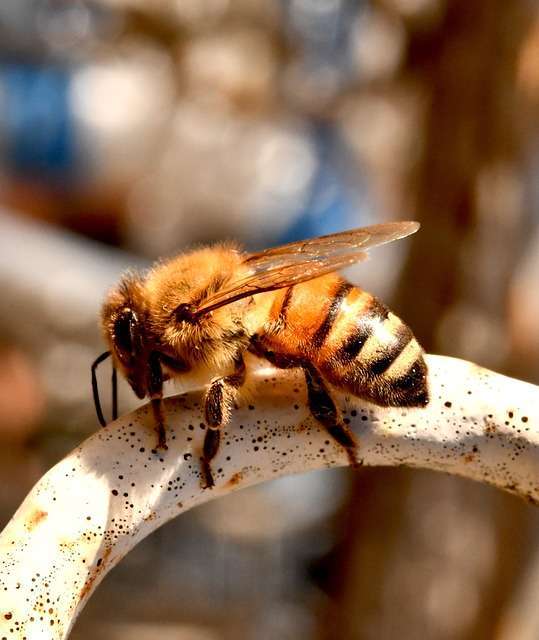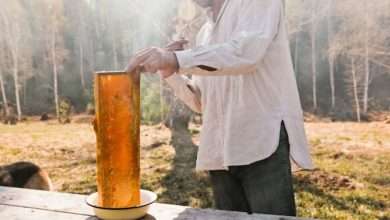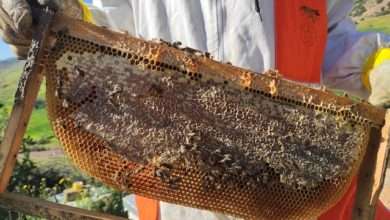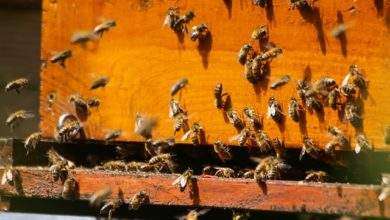How Often Should You Inspect Your Colonies? – Frequency of Hive Inspections

Beekeeping is a fascinating hobby and a crucial industry that provides significant contributions to both the environment and the economy. Maintaining healthy beehives is essential for honey production, pollination, and overall environmental balance. One of the primary ways to achieve this is through regular inspections.
In this article, we’ll discuss the frequency of hive inspections and provide helpful tips for successful hive management.
Why Inspect Your Bees?
Regular inspections of your beehives are essential to monitor your colony’s health, identify potential problems early, and intervene before they escalate. Inspections allow you to detect pests and diseases, ensure adequate food and water supply, and prevent swarming, among other critical aspects that keep your bees thriving.
When to Inspect
The timing of your inspections depends on the season and the specific needs of your colony. You should conduct inspections when the weather is warm and sunny, as bees typically become more active and less aggressive under such conditions.
One of the most important duties of beekeeping is inspecting the beehive regularly. The timing of these inspections is critical to ensure the health and well-being of the colony. In this chapter, we will discuss when you should inspect your beehive and the factors that determine the frequency of inspections.
Factors that determine the frequency of inspections include:
- Weather conditions – Weather plays a significant role in beekeeping. Inspecting your hive during unfavorable weather conditions such as rain or strong winds may upset the bees and disrupt their normal routine. It is advisable to inspect during calm, warm weather conditions, preferably when the temperature is between 60°F to 100°F.
- Season – Different seasons call for different inspection frequencies. During spring, there is much activity in the hive, and inspections should be carried out once a week to ensure that the queen is laying eggs, and the brood is healthy.
- Objective of the inspection – The reason for the inspection will determine its frequency. If you are conducting a routine inspection to check for the general health of the hive, then it can be done once a month. However, if you suspect a problem such as disease or pest infestation, then you need to inspect the hive weekly.
The timing of beehive inspections plays a crucial role in the productivity and survival of the colony. Weather conditions, season, and objective of the inspection are some of the factors that determine the frequency of inspections. It is important to keep a record of the dates and findings of the inspections for future reference.
Some essential periods of the beekeeping calendar when inspections are necessary are:
- Spring: This is the time when colonies start to expand quickly, and the queen begins laying eggs intensively. Inspect your hives frequently to monitor colony strength, brood pattern, and food supply.
- Summer: This is the peak of the beekeeping season, and your colonies will be especially active. Inspect your hives frequently to detect potential problems early and intervene before they escalate.
- Fall: This is the time when beekeepers harvest honey, so it’s essential to inspect your hives to determine if the colony has enough food for the winter. Also, check for pests like mites and beetles that may cause damage during the winter.
- Winter: During the cold months, you don’t need to inspect your hives since your bees are in hibernation. However, you should check the hive entrance regularly to ensure it’s not blocked by snow or debris.
How Often Should You Inspect Your Bees?

The frequency of your inspections depends on the time of year, the state of your colony, and your beekeeping goals. During peak beekeeping season, it’s recommended that you inspect your hives every seven to ten days to ensure the well-being of your bees.
In the early spring, beekeepers should inspect their hives once every week to monitor brood production and food supply. Since this is the busy season for the colony, there is a lot to do in terms of comb building and brood rearing, and things can quickly get out of hand if left unchecked.
In the summer months, frequent inspections are essential to monitor the colony’s health, pest management, honey production, and prevent swarming. Inspect your hives every seven to ten days during this season.
As fall approaches, it is essential to inspect your hives once every two weeks to check for food supplies and ensure your bees are ready for winter. Inspections during this season are also crucial for pest control, as varroa mites and beetles tend to multiply during the colder months.
In the winter season, you should check on your beehives once a month to ensure food supplies are adequate and there is no activity outside the hive.
What to Look for During Inspections
During your hive inspections, it’s essential to look out for the following signs, which indicate the health of your colony.
- Brood Pattern: Check for an organized brood pattern, which indicates healthy larvae and bees
- Queen Health: Look out for your queen’s presence, her ability to lay eggs, and an even brood pattern.
- Food Supply: Check for adequate food stores and supplement if necessary.
- Disease and Pests: Inspect your hive for any signs of disease or pests, which may require swift intervention.
- Honey Production: Check for honey production, which is a key indicator of colony health and a potential source of revenue.
Tips on How to Conduct Hive Inspections
A beekeeper must conduct routine hive inspections to ensure that the hive is healthy and thriving. It is essential to examine the hives regularly to identify any health issues, pests, and diseases that can affect the bee colony. Hive inspections are also an excellent opportunity to observe and learn about the behavior of the honeybees.
Here are some tips on how to conduct hive inspections effectively:
1. Plan Ahead

Before conducting a hive inspection, make sure that you have all the necessary tools and equipment. This includes a smoker, protective gear, hive tool, and a notepad to record any observations or changes.
2. Choose the Right Time
Pick the right time of day to conduct the inspection. Bees are less active when the weather is cooler or overcast., so it is best to conduct inspections during these periods to minimize bee disturbance.
3. Start with the Entrance
The entrance of the hive is the first point of inspection. The entrance provides insight into the activity and behavior of the hive. Observe the number of bees going in and out of the hive, and check for any signs of dead bees, debris, or pollen on the landing board.
4. Observe the Brood
After inspecting the entrance, carefully lift the hive cover to observe the brood. Look for the presence of eggs, larvae, capped brood, or queen cells. Also, inspect the frames for honey and pollen stores.
5. Check for Pests and Diseases
Examine the hive for any signs of pests or diseases. Common pests include small hive beetles, wax moths, and varroa mites. Look for any signs of abnormal bee behavior, such as excessive defensiveness or irregular brood patterns, which may indicate the presence of diseases.
6. Record Observations
Record any observations or changes to the hive in a notepad or Beekeeping Journal. Keeping accurate records helps to monitor the health and growth of the hive.
Equipment Needed for Hive Inspections
Beekeeping is a meticulous process that requires a lot of attention and focus. It is important to keep your beehives healthy and happy, and one of the best ways to ensure this is by conducting regular hive inspections. To carry out hive inspections properly, you need to have the right equipment.
- Smoker – The smoker is one of the most important tools for beekeeping. It is used to calm the bees and make them more cooperative during inspections. The smoke from the smoker masks the pheromones released by the bees that signal them to become defensive. Smokers are available in various sizes and designs, but they all have a basic shape and function.
- Hive Tool – The hive tool is your go-to beehive opener. This tool helps you effortlessly separate the hive boxes or frames from each other. It’s also useful for scraping wax or propolis from the top of the frames or from the inside of the hive.
- Protective Clothing – Beekeeping can be dangerous, thus protective clothing is a crucial part of your beekeeping equipment. Protective clothing guarantees your safety while working with the bees. A sturdy bee suit or jacket can protect you from bee stinger attacks. Don’t forget to also use gloves.
- Bee Brush – The bee brush is used to sweep bees away gently from the comb or hive frames during inspections. This brush is essential when it comes to maintaining the cleanliness of the hive during inspections.
- Spray Bottle – The spray bottle is used to spray sugar water onto the frames during inspections. This calms the bees and encourages them to move out of the way. It can also be used to spray water onto the bees or to clean the hive.
With the right tools, hive inspections can be stress-free and productive. The essential tools for inspecting hives include; a smoker, hive tool, protective clothing, bee brush, and a spray bottle. The equipment ensures not just the safety of the bees but also your own safety. It is highly recommended to invest in quality equipment to aid inspections and enhance your beekeeping experience.
Conclusion
Regular hive inspections are critical to beekeeping success, and the frequency of inspections depends on the season and the state of your colony.
Properly conducted hive inspections not only help to identify any health issues, pests, and diseases affecting the colony but also provide an opportunity to learn more about the behavior and activity of honeybees.
As a rule of thumb, inspect your hives every seven to ten days during the peak summer season and once a month during winter.
FAQ

What is hive inspection, and why is it important?
Hive inspection refers to the practice of checking the health of bee colonies and assessing their productivity. It is crucial because it helps identify potential issues early on, allowing beekeepers to take corrective measures before they escalate.
What is the best time to inspect your hive?
The best time to inspect your hive is during the middle of the day when the bees are most active, and the temperatures are warm. Avoid inspecting your hive during cooler or rainy weather as this can agitate the bees and make them aggressive.
How do you know if your bees are healthy?
To determine the health of your bees, you will need to check for signs of disease, pests, and varroa mites. You should also inspect the brood patterns, honey stores, and overall behavior of the colony.
What should you do if you spot signs of disease or pests?
If you spot signs of disease or pests, you should take immediate action to prevent the problem from escalating. This may involve treating your bees with pesticides, using natural remedies or consulting with a professional beekeeper.
How can you prevent pests from infecting your hive?
To prevent pests from infecting your hive, you should keep your equipment clean, avoid using old or reused materials, and ensure proper hive management, including changing frames regularly.
What should you do if you do not know how to inspect your hive?
If you are new to beekeeping or do not know how to inspect your hive, it is advisable to seek guidance from a professional beekeeper or enroll in a beekeeping course.
How long does hive inspection take?
The duration of a hive inspection may vary depending on the size of your colony and the type of hive you are using. However, on average, hive inspection takes 30-60 minutes per hive.




